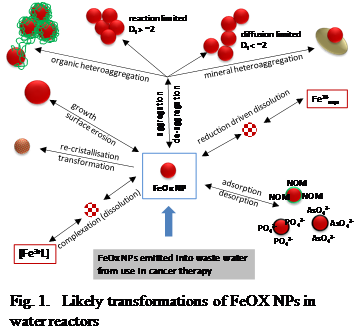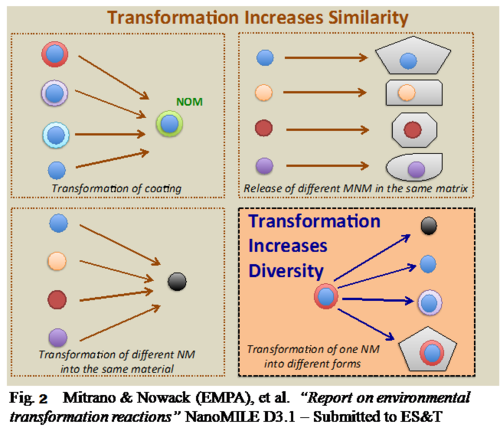Approach
NanoFASE will develop a set of novel concepts and approaches to underpin the Exposure Assessment Framework, developed as common themes linking the research, exploitation and dissemination across the different work packages.
 1. Reactors: NanoFASE will consider different release processes (e.g. weathering or direct release), waste-streams (e.g. incinerators, wastewater treatment, landfill) and environmental compartments (e.g. air, soil, water/sediment, biota) as a set of "reactors" that are able to transform ENMs from the highly engineered high energy states achieved during fabrication to environmentally transformed lower energy forms (Fig. 1). The concept of "reactors" aligns the different environmental compartments in the order that released ENMs will encounter them. This approach is consistent with the structure of multimedia fate models, where each "reactor" can be defined as a physicochemical or biological environment encountered by ENMs, in which transformations occur that govern further fate pathways. Each "reactor" model can be developed independently, and networks of reactors can be linked through a spatial transport framework to efficiently construct spatially–realistic simulations of real product value chains and environments.
1. Reactors: NanoFASE will consider different release processes (e.g. weathering or direct release), waste-streams (e.g. incinerators, wastewater treatment, landfill) and environmental compartments (e.g. air, soil, water/sediment, biota) as a set of "reactors" that are able to transform ENMs from the highly engineered high energy states achieved during fabrication to environmentally transformed lower energy forms (Fig. 1). The concept of "reactors" aligns the different environmental compartments in the order that released ENMs will encounter them. This approach is consistent with the structure of multimedia fate models, where each "reactor" can be defined as a physicochemical or biological environment encountered by ENMs, in which transformations occur that govern further fate pathways. Each "reactor" model can be developed independently, and networks of reactors can be linked through a spatial transport framework to efficiently construct spatially–realistic simulations of real product value chains and environments.
2. Functional Fate Groups (FFG): a tool to understand and reduce complexity: Each ENM form, whether transformed or not, has properties that determine its subsequent transformations. The interplay between particle properties and conditions in the environmental "reactor" in which the particle resides will determine which reactions will occur, and how fast. From the vast diversity of future ENMs and possible "reactor" characteristics, a myriad of possible outcomes could occur (see Fig. 2), especially when the potential for ENMs to pass through different reactors is taken into account.

However, dominant pathways of transformation can be identified when ENM properties, hydrochemistry and environmental colloid chemistry parameters for each "reactor" type are taken into account and once environmentally realistic observation timescales of days and weeks are considered instead of minutes. The dominance of some processes at these longer temporal scales will in many cases act to reduce complexity, e.g. through conversion of several different applied coating forms into the same effective environmentally derived coating (eco-coronas) or converging core transformations (see Fig.2).
Information on such dominant transformation and transport processes will allow ENMs to be grouped into FFGs according to their "most probable" fate pathways. The FFG concept can thus condense the richness and variability of existing and future ENMs into behavioural categories that summarise likely environmental fate and behaviour. This offers the potential to use read across to similar material as a common approach to understanding post release behaviour.
3. Multimedia fate modelling: The major tools for fate prediction within the overall Framework will be the two multimedia fate models, SimpleBox4Nano and the NanoFASE model system. SimpleBox4Nano simulates at regional to continental scale for screening level fate assessment. The NanoFASE model system will perform more complex, spatially-explicit simulations at smaller scales. It will simulate geographical area(s) as a network of cells. Within each cell, "reactors" (as described above) will be linked by transport functions (e.g. sedimentation, deposition, effluent release, soil runoff, biota uptake). Implementation of material flow among cells (e.g. water flow, air movement) will enable multimedia transport modelling and fate prediction. The model system can be made geo-specific using various GIS overlays (see Fig.3). Understanding the dynamic rates of the transformation processes in each "reactor" and how the properties of the resulting transformed ENMs affect their within- and between-compartment transport then becomes central to predicting their fate and ultimately environmental exposure
4. Use of real industrial and bespoke aged ENM test sets: To develop understanding of specific processes, NanoFASE will use a carefully selected "research and training set" of "as manufactured" and "bespoke transformed ENMs", to represent the relevant product, release, and process or environmentally aged ENM forms, in the development of the specific "reactor" process studies. A set of case study products developed by NanoFASE Industry partners will be used to provide a "validation set" including current Industrial on market, and novel near- or future-market ENMs to provide a series of cross cutting case studies for validation of the overall fate and exposure framework developed within NanoFASE.
5. Method, parameter and model catalogues: The reactor–based process understanding of ENM transformation and transport gained in NanoFASE will underpin the derivation of parameterised submodels for specific fate processes in air, soils, waters, sediments and biouptake (e.g. dissolution, (hetero)agglomeration etc.). These submodels will be incorporated into the NanoFASE model system, which will couple transformation and transport processes into a spatial framework and link them to exposure and bioaccumulation. However, to provide greater flexibility and usability of the submodels, rather than designing only a single "closed code" modelling tool, NanoFASE will also collate a catalogue of parameterised submodel algorithms, describing transformation processes, that can be incorporated by stakeholders into existing exposure and risk assessment frameworks in order to "nano-enable" them. As a demonstration of this flexibility, NanoFASE will incorporate suitable, parameterised process algorithms into the SimpleBox4Nano screening fate assessment model. SimpleBox4Nano is a development of SimpleBox, which underpins the widely used EUSES tool. As a product of model parameterisation and the Functional Fate Group categorisation, a "method catalogue" will be compiled of functional assays, including standardised ENM characterisation analysis methods that are operationalised (with the instrumentation manufacturers) for real environmental analysis. The combination of the model catalogue, and identification of the Functional Fate Groups, will also aid Safe by Design and Benign by Design Concepts, as it will inform on how basic ENM properties will affect their final environmental form(s) and distribution following environmental release, allowing this to be a relevant consideration in the design phase.
Navigate sections:
